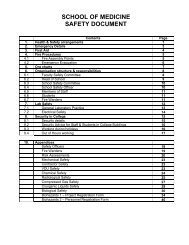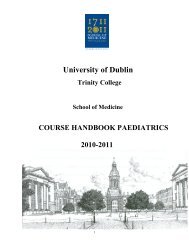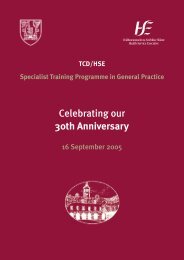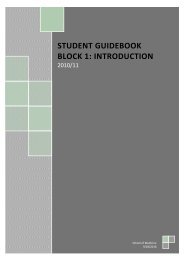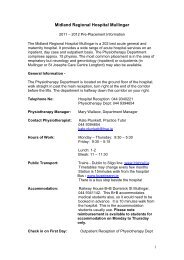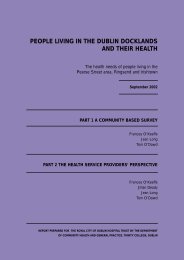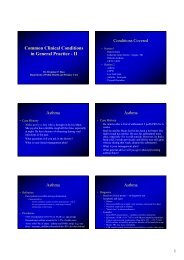C&T4; — Body Fluids Body fluids — importance
C&T4; — Body Fluids Body fluids — importance
C&T4; — Body Fluids Body fluids — importance
Create successful ePaper yourself
Turn your PDF publications into a flip-book with our unique Google optimized e-Paper software.
AHS C&<strong>T4</strong> 11/2/12<br />
C&<strong>T4</strong> — <strong>Body</strong> <strong>Fluids</strong><br />
Themes<br />
Importance of body <strong>fluids</strong><br />
(homeostasis)<br />
Fluid compartments<br />
(volumes)<br />
Boundaries and movement of<br />
materials<br />
Pathophysiology<br />
Learning Outcomes<br />
To be able to:<br />
1. describe the composition of the<br />
three principal fluid<br />
compartments in the body<br />
2. explain their respective<br />
compositions in terms of the<br />
nature of the compartments’<br />
boundaries<br />
3. explain the <strong>importance</strong> of the<br />
movement of material between<br />
compartments.<br />
4. explain the effects of tonicity on<br />
cell volume.<br />
<strong>Body</strong> <strong>fluids</strong> — <strong>importance</strong><br />
Primary transport system<br />
between cells<br />
Nutrition<br />
Waste<br />
Signals<br />
<strong>Body</strong> systems <br />
Maintain <br />
Homeostasis <br />
A large part of the<br />
Internal environment<br />
Fluid composition critical<br />
for cell function.<br />
Make<br />
up <br />
Is essential<br />
for<br />
survival<br />
of <br />
Cells <br />
Sherwood Fig. 1-5<br />
1
AHS C&<strong>T4</strong> 11/2/12<br />
Fluid Compartments<br />
42 L<br />
(60% of body mass)<br />
28 L 14 L<br />
3 L 11 L<br />
Volumes in L are those<br />
of average 70kg male<br />
NB 1 litre H 2 O weighs 1 kg<br />
Water can move between compartments<br />
Differences between Compartments?<br />
Boundaries<br />
Intracellular Fluid/Interstitial Fluid<br />
Boundary is cell membrane<br />
selectively permeable<br />
ion pumps*<br />
Interstitial Fluid/Plasma<br />
Boundary is capillary wall<br />
Permeable to small molecules<br />
Composition<br />
Interstitial Fluid (IF) Intracellular (ICF)<br />
Na + high Na + low (pump)<br />
Cl - high<br />
Cl - low<br />
K + low<br />
K + high (pump)<br />
Principal Anions<br />
PO 4<br />
3-<br />
, Proteins (Pr - )<br />
2
AHS C&<strong>T4</strong> 11/2/12<br />
Osmosis<br />
Water moves…<br />
From lower to higher solute<br />
concentration<br />
Cell membrane is<br />
semipermeable:<br />
permeable to water but<br />
not solute<br />
Movement is passive.<br />
Tonicity<br />
Effect of solute concentration on cell volume<br />
Solute cannot cross<br />
membrane<br />
Hence H 2 O moves<br />
(a) hypotonic solution<br />
Cell gains water — swells<br />
(b) hypertonic solution<br />
Cells loses water — shrinks.<br />
Important consideration in fluid replacement:<br />
Haemorrhage: Replace blood with isotonic saline (NaCl)<br />
No change in cell volume<br />
Rehydration salts (diarrhoea): Replace water and ions<br />
3
AHS C&<strong>T4</strong> 11/2/12<br />
Lymphatic system<br />
Fluid leaks out of<br />
cardiovascular system.<br />
Lymphatic system returns<br />
lymph to the cardiovascular<br />
system<br />
Systemic capillaries: allow<br />
exchange of materials<br />
between blood and body<br />
tissues – nutrients, gases (eg.<br />
O 2 , CO 2 ), water<br />
Concept: Fluid Compartments (inputs and outputs)<br />
Lymphatic drainage<br />
Sherwood Fig 10-25"<br />
3 litres per day not reabsorbed in capillaries/venules<br />
Enters lymph vessels<br />
Pumped to lymph nodes<br />
Re-enters circulation near right atrium.<br />
4
AHS C&<strong>T4</strong> 11/2/12<br />
Arrows indicate direction of force<br />
Arteriole<br />
Fig 14.19<br />
———————————————————————————————<br />
———————————————————————————————<br />
Capillary BP<br />
Colloid OP*<br />
37 mmHg 25 mmHg<br />
Capillary BP<br />
17 mmHg<br />
———————————————————————————————<br />
———————————————————————————————<br />
NET OUTWARD PRESSURE ~12mmHg NET INWARD PRESSURE~8 mmHg<br />
OUTWARD PRESSURE > INWARD PRESSURE:<br />
Fluid leaves the capillary and enters the interstitial fluid<br />
Venule<br />
*Colloid OP — osmotic pressure of plasma proteins<br />
Clue: Liver synthesises<br />
most plasma proteins<br />
Pathophysiology<br />
Liver Failure<br />
Arteriole<br />
———————————————————————————————<br />
———————————————————————————————<br />
Capillary BP<br />
37 mmHg 25 mmHg<br />
17 mmHg<br />
———————————————————————————————<br />
———————————————————————————————<br />
Fall in plasma proteins<br />
Colloid OP falls<br />
Reduced inward flow<br />
Colloid OP<br />
Accumulation of fluid in tissues (oedema).<br />
Capillary BP<br />
Venule<br />
5
AHS C&<strong>T4</strong> 11/2/12<br />
Starling’s Law — Importance<br />
Capillary wall is very permeable<br />
Bulk flow of water and solutes<br />
Rapid Plasma and Interstitial Fluid<br />
interchange<br />
Interstitial Fluid (IF)"<br />
BUT plasma is carefully regulated (kidney)<br />
Hence Interstitial Fluid composition is<br />
carefully regulated<br />
Interstitial Fluid is the environment for all<br />
cells.<br />
Normal Daily Input and Output<br />
Inputs<br />
Ingestion<br />
Fluid (1.25 litres)<br />
Food (1 litre)<br />
Metabolism (350 ml)<br />
Total 2.6 litres<br />
Outputs<br />
Gut (Faeces 100 ml)<br />
Urine (1.5 litres)<br />
Breathing/Skin (900 ml)<br />
Sweating (100 ml)<br />
Total 2.6 litres<br />
Which ones are used to regulate fluid volume?<br />
6
AHS C&<strong>T4</strong> 11/2/12<br />
Normal Daily Input and Output<br />
Inputs<br />
Ingestion<br />
Fluid * (1.25 litres)<br />
Food (1 litre)<br />
Metabolism (350 ml)<br />
* Regulated<br />
[for water balance.]<br />
Outputs<br />
Gut (Faeces 100 ml)<br />
Urine *(1.5 litres)<br />
Breathing/Skin (900 ml)<br />
Sweating (100 ml)<br />
[Only regulated for heat balance,<br />
NOT water]<br />
Abnormal Inputs and Outputs<br />
Inputs<br />
Clinical<br />
– Injection/infusion<br />
Excessive drinking<br />
(‘polydipsia) *<br />
Outputs<br />
Gut (vomiting, diarrhoea)<br />
Urine (diabetes insipidus *)<br />
Breathing/Skin (burns)<br />
Sweating (‘hyperhydria’ *)<br />
Haemorrhage.<br />
* Failure of regulation<br />
7
AHS C&<strong>T4</strong> 11/2/12<br />
Learning Outcomes !<br />
1. describe the composition of the three principal fluid compartments in the body<br />
Intracellular (ICF) — high [K + ], low [Na + ]; Pr -<br />
Interstitial (IF) — high [Na + ], low [K + ]<br />
Plasma — as IF, plus Proteins<br />
2. explain their respective compositions wrt the nature of the compartments’<br />
boundaries<br />
ICF/IF — cell membrane: semipermeable, Na + /K + pump<br />
Plasma/IF — capillary wall: bulk flow (not proteins).<br />
3. explain the <strong>importance</strong> of the movement of material between compartments<br />
Plasma/IF —plasma closely regulated (kidney) hence IF regulated<br />
ICF/IF — cell membrane regulates ICF<br />
4. explain the effects of tonicity on cell volume<br />
Osmotic effect on cell volume of solutions of different concentrations of nonpenetrating<br />
solute: hypertonic— cell loses water…<br />
<strong>Body</strong> <strong>Fluids</strong> — Summary!<br />
Key <strong>importance</strong> — homeostasis"<br />
Fluid balance (outline)!<br />
Inputs/outputs"<br />
Compartments [Core concept]!<br />
Volumes"<br />
Exchanges (Starling’s Law)"<br />
Pathophysiology (oedema)"<br />
Estimation."<br />
8






